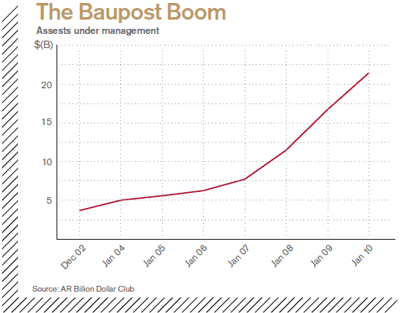Seth Klarman Part ten Portfolio Management
Post on: 12 Июль, 2015 No Comment

This is the final part of a ten part series on Seth Klarman, value investor and manager of Boston-based Baupost Group. Parts one through nine can be found at the respective links below.
- Part one. Lessons For Retail And Institutional Investors
- Part two. Value Investing in a Turbulent Environment [1997-2001]
- Part three. Value Investing In A Market Bubble [1997-2001]
- Part four. The Patient Investor
- Part five. Looking For Opportunities
- Part six. Yield Pigs
- Part seven. Wall Street Is The Worst Enemy Of The Average Investor
- Part eight. The Margin of Safety
- Part nine. Areas of Opportunity for Value Investors
Seth Klarman – Part ten: Portfolio Management
So far most of this series has been devoted to Seth Klarman’s investing strategy, detailing what he looks for in an investment and how to invest with a value slant. However, as all seasoned investors will know, while finding attractive investments is tough and time consuming, portfolio management on a day-to-day basis can make, or break a strategy. Even if you’ve made great stock picks, over trading, selling too early, or failing to keep up with economic/company specific developments can eat away at returns.
With this in mind, the final part of this series is devoted to Seth Klarmans take on portfolio management.
The information below is based on Seth Klarman’s out of print book, Margin of Safety: Risk-Averse Value Investing Strategies for the Thoughtful Investor ; hopefully you’ll find some useful tips.
“All investors must come to terms with the relentless continuity of the investment process. Although specific investments have a beginning and an end, portfolio management goes on forever…” Seth Klarman
Portfolio liquidity
Seth Klarman’s Baupost is well known for its large cash weighting, which at some points has exceeded 40%. For value investors, a high level of liquidity is extremely important, especially when investors build positions in illiquid companies. More often than not, value can only be found in illiquid assets as best opportunities usually fly under the radar. It can take years to realize results and the last thing you want to do is sell too early.
However, the opportunity cost of liquidity is high, so no investment portfolio should be completely liquid either. This is especially relevant in today’s environment. The rate of return on cash balances held within brokerage accounts is, in many cases, negligible. Even near-term cash like instruments and money market funds do not offer an attractive rate of return for cash balances. For example, the S&P 500 currently yields 1.86% on average, while the Fidelity Cash Management account currently offers an interest rate of 0.07% .
Of course, how cash you hold is dependent upon your investing style and existing portfolio of investments. A portfolio of blue chips can be turned into cash quickly, to take advantage of opportunities. While venture capital investments may take months to liquidate so a large cash balance is required.
Reducing portfolio risk
“Portfolio management requires paying attention to the portfolio as a whole, taking into account diversification, possible hedging strategies, and the management of portfolio cash flow. In effect, while individual investment decisions should take risk into account, portfolio management is a further means of risk reduction for investors…”
The two specific methods Klarman makes use of to hedge portfolio risk is the use of hedging, through derivatives and diversification. How many stocks should you hold to be suitable diversified? In Seth Klarman’s view ten to 15 is suitable. The reason for such a small portfolio size:

“My view is that an investor is better off knowing a lot about a few investments than knowing only a little about each of a great many holdings. Ones very best ideas are likely to generate higher returns for a given level of risk than ones hundredth or thousandth best idea…”
But when it comes to hedging, Seth Klarman’s view on the topic is not as well defined. Hedging can be useful but:
“Hedges can be expensive to buy and time-consuming to maintain, and overpaying for a hedge is as poor an idea as overpaying for an investment…”
However:
“When the cost is reasonable, however, a hedging strategy may allow investors to take advantage of an opportunity that otherwise would be excessively risky. In the best of all worlds, an investment that has valuable hedging properties may also be an attractive investment on its own merits…”
The Importance of Trading
Buying at the right price is critical for a value investor. Therefore, trading is central to value-investing success. Simply put, trading is the process of taking advantage of mispricings. Opportunities arise when other investors panic and companies at prices far below underlying business value, creating buying opportunities for value investors.
Stay in Touch with the Market
While some investors are comfortable buying and forgetting for the long-term, according to Seth Klarman’s principles, such a strategy seems misguided today. Financial markets are erratic and are more so today than they have been at any point in the past. It’s now easier than ever before to buy and sell securities, which has only made the market more volatile as participants rush in and out of positions.
Even when Margin of Safety was written, Seth Klarman noted that many investors were actually buying and selling securities with little or no fundamental knowledge of the underlying businesses. So, when Mr Market throws his toys out the pram, investors panic and opportunities to buy at discounted price present themselves at a rapid pace. A high level of liquidity, coupled with a knowledge of day-to-day market movements can result in plenty of value opportunities .
Buying: Leave Room to Average Down
As Seth Klarman explains:
“The single most crucial factor in trading is developing the appropriate reaction to price fluctuationsOne half of trading involves learning how to buy. In my view, investors should usually refrain from purchasing a full position (the maximum dollar commitment they intend to make) in a given security all at onceBuying a partial position leaves reserves that permit investors to average down, lowering their average cost per share, if prices declineIf the security you are considering is truly a good investment, not a speculation, you would certainly want to own more at lower prices. If, prior to purchase, you realize that you are unwilling to average down, then you probably should not make the purchase in the first place…”
Selling: The Hardest Decision of All
Anyone over the age of 18 can buy a stock. The hardest part is selling. Some investors have targets on when to sell, if the P/B value hits one, or P/E exceeds 15. These are rules Seth Klarman considers to be useless. Just like decisions to buy, decisions on when to sell must be based on the business’ underlying value, which will of course change constantly.
It may be silly to wait for full value realization. For example, missing out on half a point of profit when other opportunities are available is not the end of the world. It’s be better to take profits and reinvest with a new, wider margin of safety. Stop losses should not be used, a view held by most value investors:
“Some investors place stop-loss orders to sell securities at specific prices, usually marginally below their costAlthough this strategy may seem an effective way to limit downside risk, it is, in fact, crazya user of this technique acts as if the market knows the merits of a particular investment better than he or she does…” (What happened to Mr Market? Using stop losses puts him in control.)
Making the decision to sell is tough, it requires constant work to value the underlying business. Still, deciding on when to sell is without a doubt more important than deciding on when to buy.
“If you havent bought based upon underlying value, how do you decide when to sell? If you are speculating in securities trading above underlying value, when do you take a profit or cut your losses? Do you have any guide other than how they are acting, which is really no guide at all?”
Conclusion
That concludes this series on Seth Klarman. I hope you’ve found it useful, if not, it’s always handy to remember that while we don’t all hold the same opinions, considering a diverse range of insights will make us better investors .
Next week I’m starting a series based on the life and investing style of legendary Canadian value investor, Peter Cundill. To ensure you don’t miss the next series sign up for our free newsletter .














